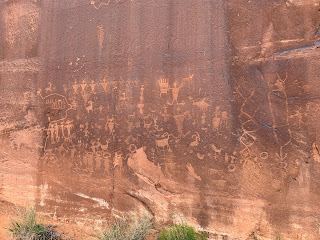With the weather starting to warm and my new Subaru Outback all set up, I'm trying to get my bike out more often. The Atlanta area has hundreds of miles of paved trails and I intend to explore many of them over the next couple of years. Today, I decided to leave work a little early and take advantage of this sunny low-80 degree day. I loaded my bike onto the rooftop rack and drove a few miles to Union Hill Park, which is one of the trailheads along the Big Creek Greenway.Big Creek Greenway extends about 26-miles from Cumming, GA to Roswell, GA across multiple surfaces, but mostly pavement and boardwalks. I don't have the time this evening, nor the fitness yet to do the entire 26-miles right now, but perhaps in the near future, I will be able to. For today, I'm hoping to get in about 12-miles.
The trailhead is nothing more than a parking area, which the well maintained paved trail runs through. I arrived at about 5 PM and luckily beat any crowds that may arrive as others get off of work. After parking my car, I pull out my step stool and take my bike down from the roof rack. I strap on my helmet, stuff my keys and wallet in the saddle pack, and hit the trail. From this starting point, I could go either direction for many miles, but decided to head south.
I did a lot of cycling as a teenager. In fact, I saved lawn-mower and snow-shoveling earnings for a whole year and bought a racing 12-speed bike when I was twelve years old. That Schwinn Tempo cost me about $400 back then, which was enormous amount of money for a boy of that age. I definitely got my money's worth though, as I rode the hell out of that bike over many, many years and only finally got rid of it when we moved from Reno to Atlanta, just a couple of years ago.Unfortunately, my fitness for riding has been neglected for decades and it's going to take some work to get my legs back into any kind of shape for long distances. While I do stay very active with running and hiking, the muscles used are quite different. I'll just have to put the work in from the saddle.
The trail is wide and well paved. It's smooth surface allows me to coast the downhill sections at good speeds. A sign indicates a 15-mph speed limit, which is roughly where I'm at. There are also a number of s-curves, which require me to slow down through certain sections. The early part of this section traverses some marshy areas and the trail had been built up over this wetland, with tall rails confining travelers. There are a few people out here, but it's not terribly busy. Those that are here though seem to be enjoying the great weather just like I am, whether they are walking, running, or cycling.
I'm trying to push myself a little, but I'm also trying to get use to the gears and shifting between them on this new bike. Today is only the second time I've been on it. I'm also still getting used to the changes in style/technology from my when I rode regularly many years ago. On my old Schwinn, the gear shifts were levers along the lower main frame bar, while this new bike has them built into the break levers and pushing left or right causes a shift. I'm also still getting used to the absence of what I know as safety lever brakes. These are secondary activators that run parallel with the middle section of the handle bar and allow the rider to be more upright instead of grabbing the "horns of the ram". I'm considering getting a set of these activators installed if I can find them, but we'll see.

After crossing a few bridges and traversing a few more miles, I reach Rock Mill Park and decide this would be a good turning point. I decide to stop for a breather, restroom break, and answer a few chats from work. When I've rested for a few minutes and hydrated a bit, I feel like it's time to head back and remount the bike. While I pushed myself pretty hard on parts of this trail, I convince myself that it's okay to take the return trip a bit more leisurely. After all, I'm not in any big hurry.

I stop a few times to take some pictures that I had mentally marked on the initial ride through this part. It also gives me a chance to drink more water. Finally arriving back at my car, I check the GPS tracking app and find that I rode about 12.7 miles, which I'm pretty happy with. It's about a little shy of 6:30 PM and I should be home in time for dinner. My legs are definitely telling me that they aren't used to this kind of treatment, but I guarantee they are in for a lot more. As for the trail, I really enjoyed this section and I will definitely be riding other sections in the near future.




















































